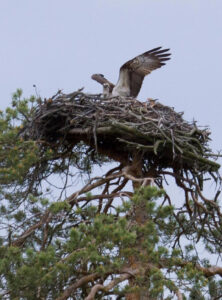Third International Scientific and Practical Conference “Eagles of the Palearctic: Study and Conservation”
Raptors Conservation. Suppl. 2. Proceedings of Conferences
Long-Term Population Dynamics of Large Raptors in the Important Bird Area “Kamsko-Bakaldinskiye Marshes” (Nizhny Novgorod Region)
Bakka S.V. (Nurgush State Nature Reserve, Kirov, Russia)
Kiseleva N.Yu. (Minin Nizhny Novgorod State Pedagogical University, Nizhny Novgorod, Russia)
Shukov P.M. (Nizhny Novgorod Branch of Russian Bird Conservation Union, Ecological Center “Dront”, Nizhny Novgorod, Russia)
Contact:
Sergei Bakka sopr_nn@mail.ru
Nadezhda Kiseleva sopr@dront.ru
Pavel Shukov shukov.pm@gmail.com
Recommended citation: Bakka S.V., Kiseleva N.Yu., Shukov P.M. Long-Term Population Dynamics of Large Raptors in the Important Bird Area “Kamsko-Bakaldinskiye Marshes” (Nizhny Novgorod Region). – Raptors Conservation. 2023. S2: 116–120. DOI: 10.19074/1814-8654-2023-2-116-120 URL: http://rrrcn.ru/en/archives/34915
Identification of breeding territories and long-term population monitoring has been carried out in the Important Bird Areas (IBA) with a global importance “KamskoBakaldinskiye marshes” since 1980. Five large bird species were studied here: Osprey (Pandion haliaetus), Short-Toed Eagle (Circaetus gallicus), Greater Spotted Eagle (Aquila [Clanga] clanga), Golden Eagle (Aquila chrysaetos), White-Tailed Eagle (Haliaeetus albicilla). In this report we will summarize the results.
IBA covers the northern (Zavolzhsky) part of the Lyskovsky and Vorotynsky districts of the Nizhny Novgorod region, as well as the adjacent areas of Borsky, Semenovsky, and Voskresensky districts. Its total area is 3156.0 km2. The largest massif of upland, transitional, and lowland bogs in the Volga River basin is preserved here in its natural state. A significant part of IBA area (2265 km2) is listed as Ramsar wetland of international importance.
Kamsko-Bakaldinskiye marshes has undergone significant transformation over the past 50 years. Until the 1980s, intensive logging was carried out here with an excess of the allowable cutting area. Protected areas were organized by 1994, covering 54% of IBA area and leading to a decrease in logging volumes. In the 1980s drainage and peat extraction amounted to 1% of an area. Disastrous fires of 1972 and 2010 spread through about 50% of an area. The number of rare raptor species was positively influenced by the implementation of a unique project to install 62 nesting platforms in 1998–2014.
Multidirectional vectors – the destruction of habitats and their conservation, combined with compensatory biotechnical measures, superimposed on the general population trends of large raptors in the center of the European part of Russia. As a result, the population dynamics of different species in Kamsko-Bakaldinskiye marshes differs significantly (Table 1).
The population dynamic for four out of five studied species shows a clear positive trend. Thus, the number of Osprey and White-Tailed Eagle has increased by three and six times, respectively. A project that included nesting platform installation had a significant impact on Osprey population. White-Tailed Eagle depended on it to a lesser extent, however, throughout an entire observation period, there was a general positive trend in the abundance of the species in the European part of Russia. The negative impact of catastrophic fires in 2010 on Osprey and White-Tailed Eagle was insignificant.
Abundance of Short-Toed Eagle and Greater Spotted Eagle in 2000–2014 was severely underestimated. After 2014, additional data were collected, which allowed us to determine the abundance and distribution of these species in studied area, as well as to identify a positive population trend. In 2000–2014, actual ShortToed Eagle abundance was twice as high as estimates made in the period (Table 1). Subsequently, a favorable factor for ShortToed Eagle was the large burnt area left by fires, which the birds used as new hunting grounds. A twofold increase in Short-Toed Eagle population happened in 2011–2023.
The difference in estimates of Greater Spotted Eagle abundance in 2014 and 2018 is mainly due to the results of additional research efforts. Breeding territories have been identified in previously poorly studied floodplain habitats. In addition, the number of Greater Spotted Eagle increased slightly after the fires of 2010 destroyed most of its breeding territories in Kamsko-Bakaldinskiye marshes.
The number of Golden Eagle significantly increased in 2000–2010 due to the use of nesting platforms. Then it began to decline due to the long-term depression in Mountain Hare and Grouse populations, as well as catastrophic fires that affected most of breeding territories. Thus, Golden Eagle turned out to be the most vulnerable to pyrogenic changes in their habitat. The number of the species has fallen to the lowest point, almost reaching level of the 1980s. Species’ breeding territories are only preserved in areas unaffected by fires.
Table 1. Large raptors population dynamic at KOA “Kamsko-Bakaldinskiye marshes” in 1980–2023.
| Periods of observation | Estimation of the number of studied species, pairs | ||||
| Osprey Pandion haliaetus |
Short-Toed Eagle Circaetus gallicus |
Greater Spotted Eagle Aquila [Clanga] clanga |
Golden Eagle Aquila chrysaetos |
White-Tailed Sea Eagle Haliaeetus albicilla |
|
| 1980–1995 | 5–6 | 2–3 | 2–3 | 1–3 | 2–3 |
| 2000–2003 | 8–9 | 3–4 | 3–4 | 4–5 | 2–3 |
| 2007–2010 | 12–15 | 3–4 | 3–4 | 9–10 | 4–5 |
| 2011 | 12–16 | 3–4 | 3–4 | 9–10 | 10–12 |
| 2014 | 13–16 | 3–4 | 3–4 | 7–10 | 11–15 |
| 2018 | 16–19 | 11–13 | 12–15 | 5–6 | 12–16 |
| 2023 | 16–19 | 12–14 | 12–15 | 3–4 | 12–16 |
Golden Eagle’s population decline has had a positive impact on populations of other large raptor species, especially noticeable for Greater Spotted Eagle. The emergence of its breeding territories was noted where Golden Eagle’s breeding territories were lost due to fires.
Kamsko-Bakaldinskiye Marshes currently remains the most important refugium for rare large raptor species in Nizhny Novgorod Region, where it is advisable to expand and strengthen protected areas and restore permanent implementation of biotechnical projects.

